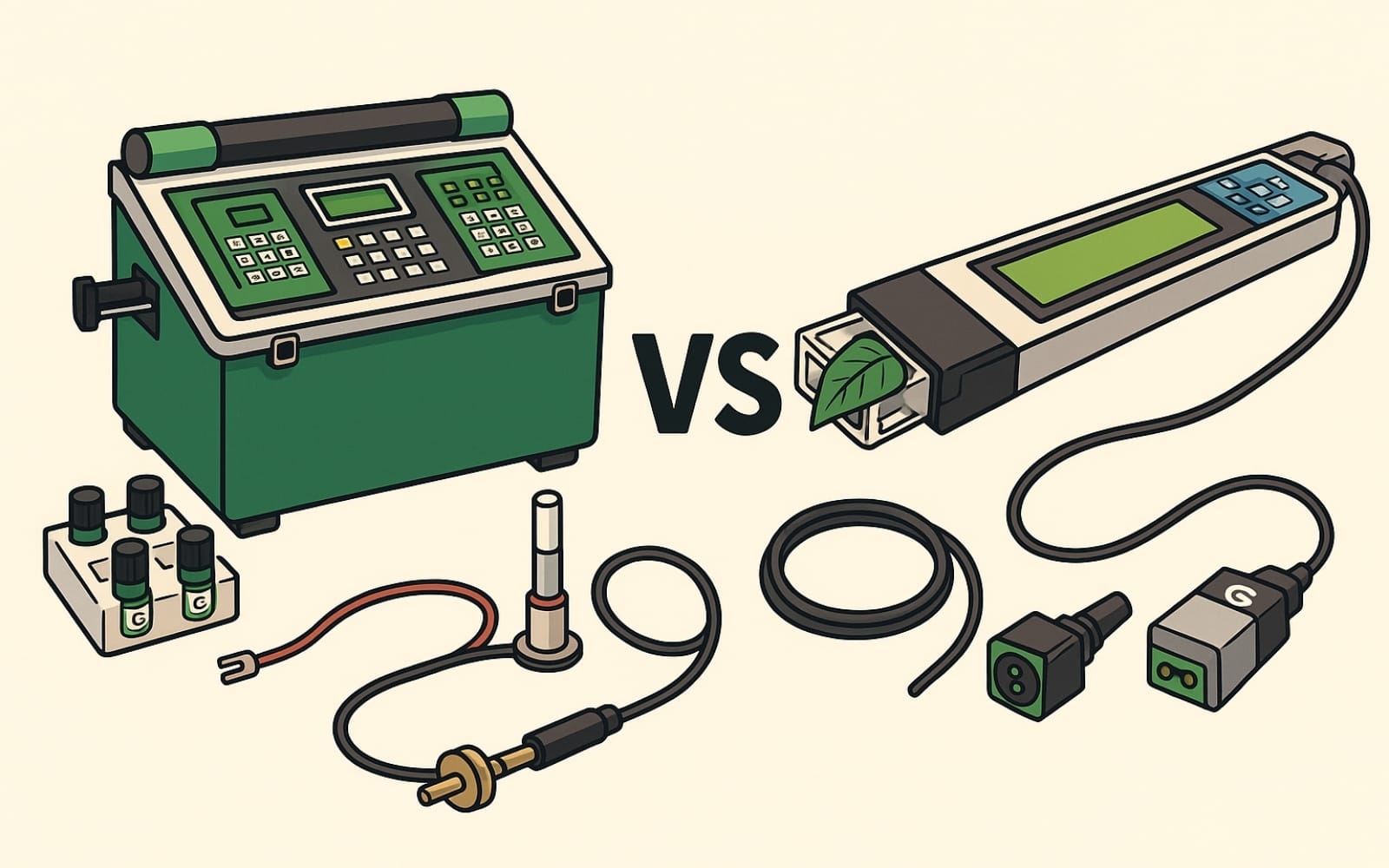November 18, 2025 at 5:55 pm | Updated November 18, 2025 at 5:55 pm | 4 min read
Accurate photosynthesis measurement is vital for understanding plant physiology, crop productivity, and responses to stress. Portable gas exchange systems have become essential in both field and controlled studies.
Among the leading instruments in this field of photosynthesis measurement systems are CID Bio Science’s CI 340 Handheld Photosynthesis System and LI COR’s LI 6400XT.
Both provide reliable data, but their design philosophies differ sharply. Researchers looking for flexibility, portability, and efficiency often compare the two.
Subscribe to the CID Bio-Science Weekly article series.
By submitting this form, you are consenting to receive marketing emails from: . You can revoke your consent to receive emails at any time by using the SafeUnsubscribe® link, found at the bottom of every email. Emails are serviced by Constant Contact
Overview of the CI 340 Handheld Photosynthesis System

The CI 340 is a compact, fully integrated photosynthesis measurement system designed for mobility and speed. It measures photosynthesis, respiration, transpiration, stomatal conductance, PAR (photosynthetically active radiation), and internal CO2 concentration. All of these are measured in one handheld unit.
The gas analyzer connects directly to the chamber, minimizing delay and improving data accuracy. Optional modules allow control over CO2, H2O, temperature, and light intensity, giving it the versatility of larger systems in a portable format.
Key Features:
- Lightweight and optimized for single-handed operation
- Stable analyzers for accurate CO2 and H2O measurements
- Ten interchangeable chambers for different leaf types, including needles and cacti
- Optional chlorophyll fluorescence module for simultaneous fluorescence and gas exchange analysis
- Control modules for manipulating light, temperature, and gas composition
This flexibility allows one photosynthesis measurement system to support a wide range of experimental designs without additional recalibration or bulky equipment.
Overview of the LI COR 6400XT Portable Photosynthesis System

The LI 6400XT is a larger, modular system widely used for advanced photosynthesis and gas exchange studies. It offers open and closed system measurements and allows precise control of environmental parameters inside the leaf chamber. The instrument connects via a console with a color touchscreen and multiple sensors for CO2, H2O, temperature, and light.
Key Features:
- Customizable chambers and sensors
- Fine control over CO2 and light conditions
- High measurement precision for detailed physiological studies
While the LI 6400XT is powerful, it requires more setup time, power supply, and maintenance. Its larger size can limit mobility during extensive fieldwork.
Comparing Performance and Practical Use
Portability and Ease of Use
The CI 340’s lightweight design stands out immediately. It can be operated with one hand and carried easily between plots. Its all-in-one design removes the need for external consoles, gas tanks, or tubing. For field researchers working in rugged or remote areas, this portability makes data collection much easier.
The LI 6400XT, though capable, is less field-friendly. Its multiple components and heavier frame require more setup and transportation effort.
Measurement Speed and Data Quality
Direct chamber connection to the CI 340’s gas analyzer reduces lag, allowing fast and reliable readings. The stability of its CO2 and H2O analyzers ensures accuracy even when ambient conditions fluctuate.
The LI 6400XT also provides precise readings but often demands longer calibration and setup. For time-sensitive studies or large datasets, the CI 340’s rapid response can significantly increase productivity.
Control and Customization
Both instruments allow environmental control but in different ways. The LI 6400XT includes integrated systems for controlling CO2, temperature, and light, making it ideal for highly controlled physiological studies.
The CI 340’s modular approach lets users attach specific control modules when needed:
- Light Module adjusts light intensity for light-response curves.
- Temperature Module modifies leaf chamber temperature.
- H2O and CO2 Module controls gas concentrations.
- Chlorophyll Fluorescence Module measures fluorescence alongside photosynthesis.
This setup gives flexibility without adding unnecessary weight or cost when full control isn’t required.
Maintenance and Calibration
The CI 340 requires minimal calibration and offers a straightforward interface. LI COR’s 6400XT, while providing more calibration options, needs regular upkeep to maintain sensor precision. This makes the CI 340 more convenient for long-term use and ideal for teams without technical staff.
Cost and Accessibility
The CI 340 generally comes at a lower cost than the LI 6400XT, depending on configuration. This makes it an accessible photosynthesis measurement system for smaller labs and educational institutions, while still delivering research-grade performance.
Field Applications: CI 340 in Action
Researchers across agronomy, ecology, and horticulture use the CI 340 for various studies:
- Ecologists measure seasonal changes in photosynthetic rate relative to temperature shifts.
- Agronomists assess water status and genotype differences in crops.
- Horticulturalists analyze physiological changes caused by drought or nutrient stress.
Because this photosynthesis measurement system accommodates diverse leaf types and environmental conditions, it fits studies from desert plant physiology to forest canopy monitoring.
Which System Fits Best?
If a research project prioritizes portability, efficiency, and versatility, the CI 340 is an ideal choice. It captures accurate data in both controlled and field environments without the logistical challenges of larger systems. The LI 6400XT remains a strong option for highly controlled laboratory work where environmental precision is key.
Many researchers see the CI 340 as a practical alternative, offering most of the analytical power of the LI 6400XT at a fraction of the size, weight, and cost.
Final Thoughts
The CI 340 Handheld Photosynthesis System reflects CID Bio Science’s focus on usability and research flexibility. It helps scientists collect meaningful physiological data without the constraints of bulky instruments.
In a field where time, location, and environmental variability matter, a portable and reliable photosynthesis measurement system like the CI 340 can redefine how photosynthesis is studied.
FAQs
1. Can the CI 340 replace a full-size lab photosynthesis system?
For most field and applied studies, yes. It offers comparable precision and functionality with added portability. However, for highly controlled experiments requiring long-term environmental manipulation, a full lab system may still be preferred.
2. Does the CI 340 support fluorescence measurements?
Yes. With the optional Chlorophyll Fluorescence Module, users can measure fluorescence alongside gas exchange for comprehensive photosynthetic efficiency studies.
3. What type of leaves can the CI 340 measure?
The CI 340 offers ten interchangeable chambers that handle various leaf types, from broad leaves to needles and cacti, ensuring flexibility across different plant species.
Related Products
Most Popular Articles
- Transpiration in Plants: Its Importance and Applications
- Leaf Area – How & Why Measuring Leaf Area…
- How to Analyze Photosynthesis in Plants: Methods and Tools
- Plant Respiration: Its Importance and Applications
- The Forest Canopy: Structure, Roles & Measurement
- Stomatal Conductance: Functions, Measurement, and…
- Forest & Plant Canopy Analysis – Tools…
- Root Respiration: Importance and Applications
- The Importance of Leaf Area Index (LAI) in…
- Irrigating with Saline or Seawater






